Transmission of Craftsman Techniques
Working to Pass Down Skills at Kawasaki Factory Systematic training to polish skills and train personnel
Fuji Electric Kawasaki Factory manufactures steam turbines, generators, and other equipment used in generating renewable energy (geothermal power and hydroelectric power) and environmentally-friendly efficient thermal power. These products are custom manufactured for each customer, so their machining and assembly relies on human feeling and requires master-level skills. It is for this reason that Kawasaki Factory established the “Skill Transfer Center” in 2008 to promote cross-training, with the goals of quickly training young/core technicians to replace retiring baby boomer-age workers and transferring workloads to press forward with systematical education for developing skilled workers.
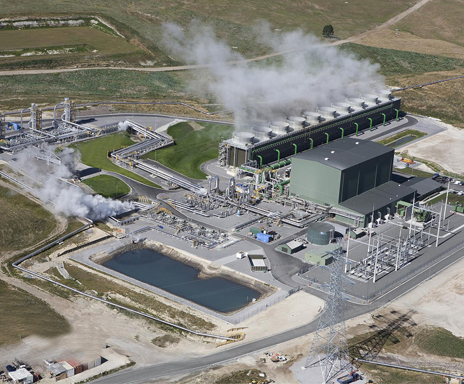
Nga Awa Purua, the world’s largest geothermal power station, uses power generation equipment provided by Fuji Electric (New Zealand)
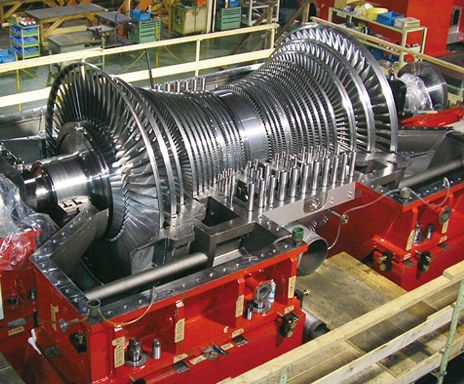
Power generation equipment manufactured in Kawasaki Factory (steam turbine)
Senior and junior employees are paired off in “teacher/student” relationships
“At Kawasaki Factory, a lot relies on the high skill of each individual worker, and we handle a lot of large products. Manufacturing these products requires precision to the micrometer. This makes it difficult to pass skills on to younger workers, and it takes a long time to train people. That’s why we established the Skill Transfer Center in Kawasaki Factory in preparation for the so-called “2007 issue,” where our baby boomer employees all want to retire at once.”
So explains Takamitsu Sato, Center Chief. “From-To Activities” were launched with the goal of transferring skills in a planned manner.
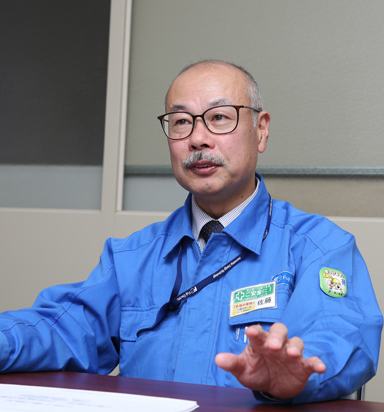
Takamitsu Sato, Skill Transfer Center Chief
During “From-To Activities,” two employees are paired off with one serving as “teacher” and the other as “student,” and then the former attempts to teach his or her skills to the latter one-on-one. It’s the responsibility of these “teachers” (senior employees) to teach their skills to their “students” (junior employees). 。
“The types and levels of skills required for each product differ, such as cutting, welding, and assembly. First, we made a list of all of these and then sat down and thought about who should teach whom. Supervisors then designed training programs based on workplace conditions and the skill level of each person. There’s also another benefit to doing this, as senior employees end up deepening their knowledge when they have to teach a junior employee something, leading to growth for senior and junior employees alike.”
Training results are summarized together with direct manager comments in monthly reports, and each workplace provides an overall report on progress and results at the start of the following fiscal year. Now, everyone is aware of skill levels in workplaces. They also hold a Skills Competition each half-term. All of these efforts have created a workplace culture of friendly competition where coworkers compete with one another to show off their skills.
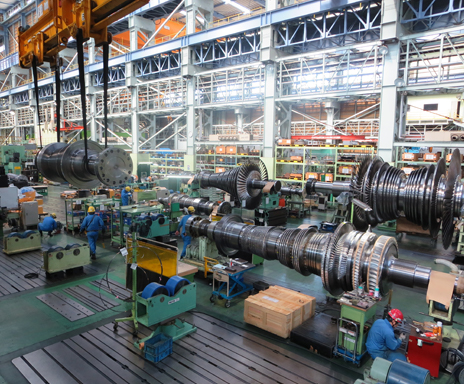
Manufacturing a steam turbine
A clear “BANG” is a sure indication of skill level
Akinori Iwata and Ryosuke Akama are a pair of workers in the Manufacturing Division, Thermal Power Manufacturing Section, where they are responsible for installing blades to rotors on steam turbines. Steam turbines are central parts for thermal/geothermal power generation equipment. The blades are struck by steam created by a boiler (or magma in the earth, for geothermal power generation), causing the rotor to rotate 3,600 (or 3,000) times per minute. This force is transmitted to the generator, creating electricity.
Mr. Iwata, who is responsible for teaching Mr. Akama, explains how difficult this work is.
“Blades need to be installed to the rotor at equal intervals or pitches, without any gaps. As you get closer to the end, you need to finely adjust the pitch. While you’re doing this, you’re inserting a blade that might weigh as much as 50 kilograms into a groove and setting it in place by hitting it with a heavy hammer. This kind of work requires both strength and a subtle touch.”
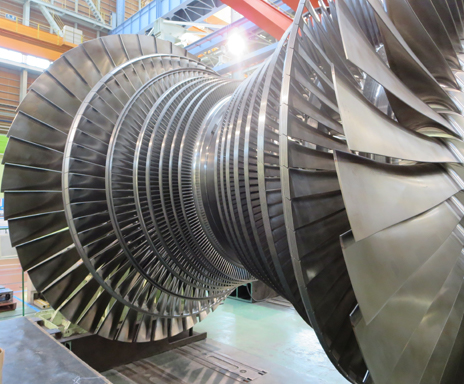
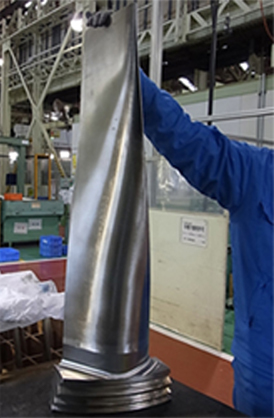
A steam turbine (L); blades (R) are installed to rotors
Blade installation works like this. First, a blade is inserted into a groove on the rotor. A bonding material called a “piece” is brought into contact with the blade and rotor to be fixed, and then it is crushed by striking it with hammer and chisel. Finally, the worker strongly strikes the base of the blade to set it firmly in place, so that the blade does not loosen even during high speed rotation.
There are around 100 blades around the entire rotor, and installing a single blade can take 20 or more hammer swings. The area of the chisel being struck has a diameter of only several centimeters and the hammer weighs over two kilograms. Missing the target can cause serious injury and could also damage the product. The work requires utmost concentration.
Once a worker reaches the last 20 blades, he or she needs to then begin thinking about final finishing as he or she continues hammering. Although the number of blades is calculated in the design to just fit, the amount of strength used when hammering varies by person. The blades themselves even expand and shrink due to heat and humidity. Workers therefore need to keep the finished form in mind as they finely adjust their hammering. “If it’s a bit of a tight fit when hammering that last blade, you know you’ve got it right,” explains Mr. Iwata.
It is impossible to tell the quality of the work just by looking at the product. The final finish of the work is influenced by the worker’s feel. This is why it is so hard to transfer skills from one employee to another.
“I try my best to explain things in words or in writing, but there are still some things you just can’t explain that way. We also tried automating processes using machines, but we ended up giving up on that due to how hard it is to finely adjust your power and angle when hammering. The only way to teach someone else is to work in pairs and get on the same page together in terms of the “feel” of work,” explains Mr. Iwata.
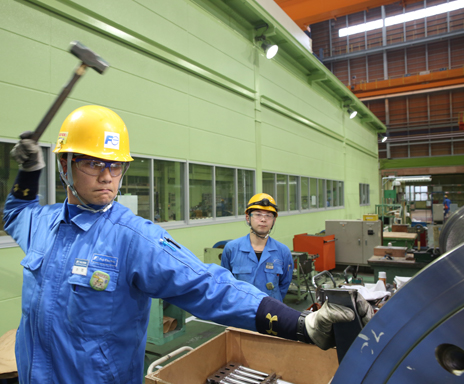
Getting ready for a powerful swing of the hammer at the chisel, with a hammer in his dominant hand and a chisel in the other
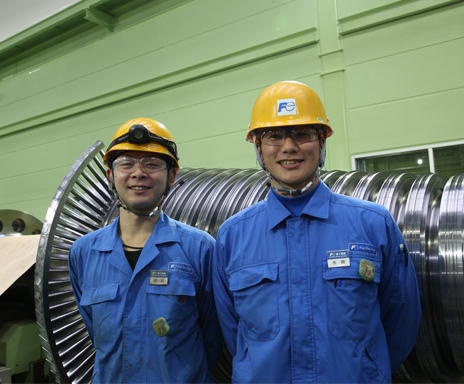
Akinori Iwata (L) and Ryosuke Akama (R) from the Manufacturing Division, Thermal Power Manufacturing Section
Although the feel is important, Mr. Iwata explains that the best thing to rely on is the sound the hammer makes when it hits the chisel.
“If you hit it just right, you get a clear “BANG” you can hear throughout the factory. Even if you’re 50 meters away in the office, you can tell straight away if a veteran worker is swinging the hammer.”
So how long does it take to master the skills required to install blades? “It takes three years to finally get the hang of it, but even 10 years isn’t long enough to master it,” explains Mr. Iwata. A lot of it depends on feel. Mr. Akama had the following to say on “From-To,” from his perspective as a junior employee learning skills in this way. 。
“Although we do have a final performance test, the one who did the actual work is the only one who understands the precision of blade installation. I realize this job carries huge responsibility, and I’d like to improve my skills. First though, I’ve got to make sure I can do what I’ve been taught. I’ve picked up some tricks to help along as I work, such as taking notes and writing instructions down in a way that makes sense to me.”
Teaching the next generation the true essence of manufacturing
Shota Sugimura (in his ninth year at Fuji Electric) and Tokuya Nishioka (in his fourth year) are responsible for lathing a wide range of parts, from thermal/geothermal steam turbines and generators, to parts related to hydroelectric and nuclear power generation. Although much of this work is automated using numerically controlled machines called NC lathes, both men use old-fashioned general-purpose lathes in addition to the newer NC lathes.
When lathing a workpiece using a general-purpose lathe, a lathe turning tool called a “bite” is pressed against a rotating part. The lathing condition is finely adjusted by manually operating a handle. These machines are used to lathe a wide range of parts, from bolts and nuts only several tens of millimeters small, to core parts at large as 500 millimeters. Workers carefully set up (prepare) each job—from selecting tools to determining cutting conditions—and make use of their own experience, knowledge, and skill in finishing parts.
Steam turbines are constantly exposed to extremely hot (roughly 600°) steam when generating thermal power. Some turbines have been in use for more than 40 years, and there has been increasing demand for after-sales service and other repair work as power generation equipment provided by Fuji Electric ages. This necessarily means that Mr. Sugimura and Mr. Nishioka, who operate general-purpose lathes, often get called on for emergency support work.
「“Although most parts can be lathed using an NC lathe, there are still some situations calling for a general-purpose lathe. Maintenance is one example. Parts that have worn over long-term use can be welded back into shape. However, it can be more efficient and accurate for an experienced worker to follow the instructions in diagrams and use a general-purpose lathe—which can turn on a dime—instead of using a large NC lathe to finish the welded portion.”
NC lathes are used for the majority of lathe work in Kawasaki Factory. However, Mr. Sugimura is adamant that the analog nature of general-purpose lathes condenses all the basics for this kind of work.
“We handle over 100 parts a year. The type of bite and the speed at which you turn the handle differs depending on a wide range of factors including the size, shape, and material. If the bites you have on hand can’t be used to lathe according to your conditions, you have to make your own. Although general-purpose lathes don’t necessarily require a “master’s touch,” using one to accurately lathe a part requires you to know the basics of cutting. You can also use the experience and knowledge you’ve gained using general-purpose lathes when setting lathing conditions on an NC lathe.”
When asked about how he provides instruction, Mr. Sugimura explains, “I don’t get too detailed.” However, Mr. Nishioka adds that Mr. Sugimura is sure to explain the importance of “setup” as one step in the work process.
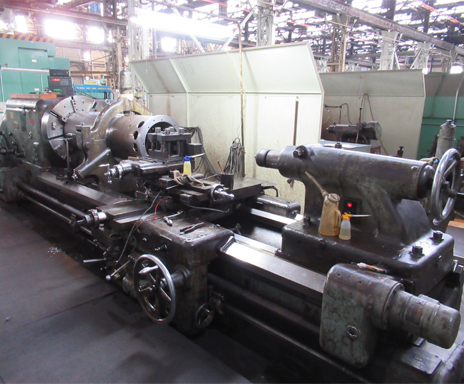
A general-purpose lathe where parts are lathed by operating a handle
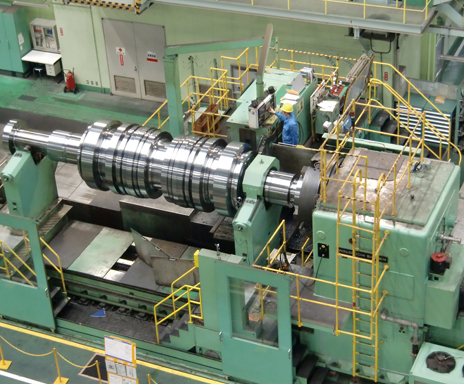
An NC lathe that automatically lathes parts using numerical control
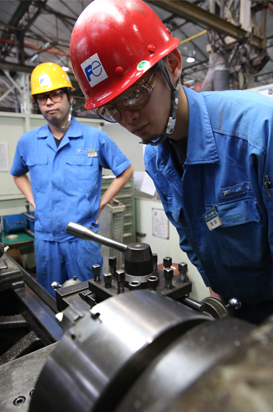
Learning how to operate a general-purpose lathe from a senior employee
“One of the most important parts of setup is ‘centering.’ Before you start lathing with a general-purpose lathe, you secure the part in place from all directions using pieces of iron called ‘chucks.’ If you don’t center the part perfectly during preparation, you won’t be able to lathe at the required precision. A misalignment of only several micrometers (1/1000th of a millimeter) can cause a defect in power generation equipment. Every day I realize how important it is to follow the procedure and think each step of the way.”
Although the teaching relationship is described here as “one-on-one,” that does not mean that employees are taken by the hand and taught step-by-step. Each employee has his or her own work to do, and most time is spent on one’s own work. Mr. Sugimura has his own interpretation of what “From-To” means.
“It means teaching the next generation the true essence of work—and that’s the root of all manufacturing. I truly believe that this is my mission.”
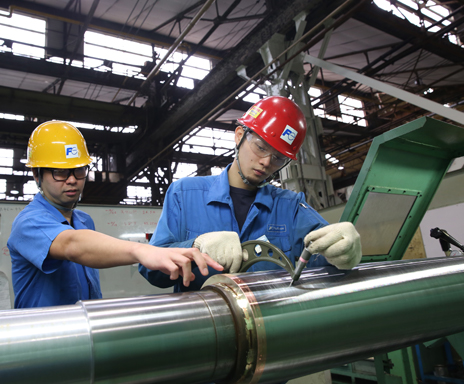
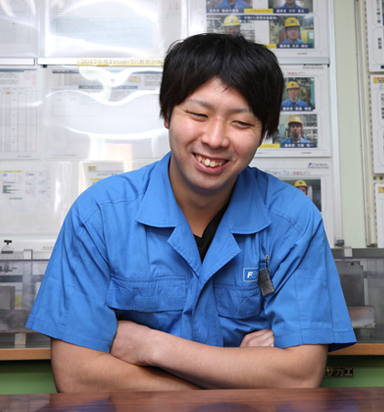
Shota Sugimura from the Manufacturing Division, Machine Section
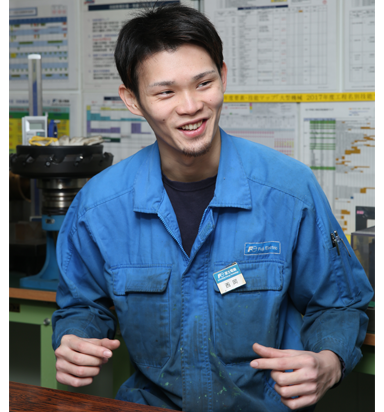
Tokuya Nishioka from the Manufacturing Division, Machine Section
Continuing efforts to help improve manufacturing quality
In March 2018, Kawasaki Factory will hold a Skills Competition with Chiba Factory, which manufactures new transformers and other large products. The goal is for workers handling different products to study and learn from each other. In closing, we asked Mr. Sato, Center Chief, about what he felt was important in training manufacturing personnel.
“I’m sure that there’s a difference in how young people think compared with people long ago, who took immense pride in their work. However, the true essence hasn’t changed, and I think the most important thing is curiosity—that feeling of wanting to learn about something you don’t know, or wanting to learn how to do something new. Curiosity about manufacturing develops one’s feeling and imagination as a master. Toward that end, we’d like to stimulate the curiosity of technicians and continue our efforts to help improve manufacturing quality.”


